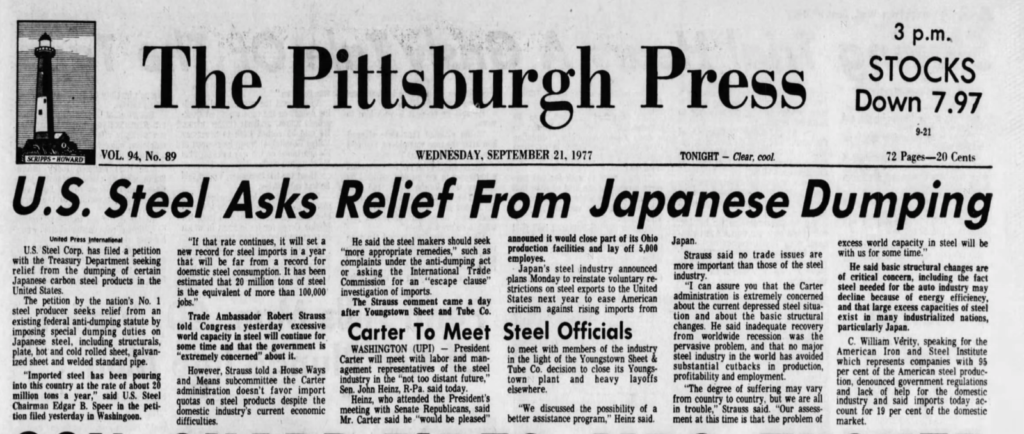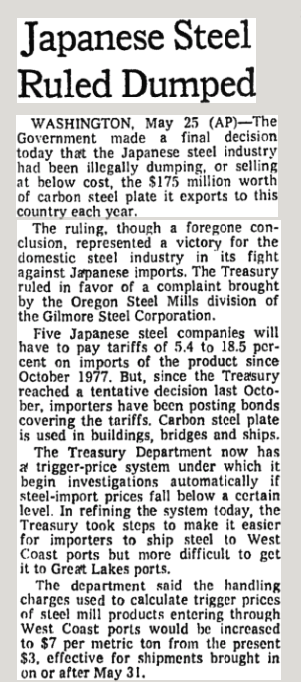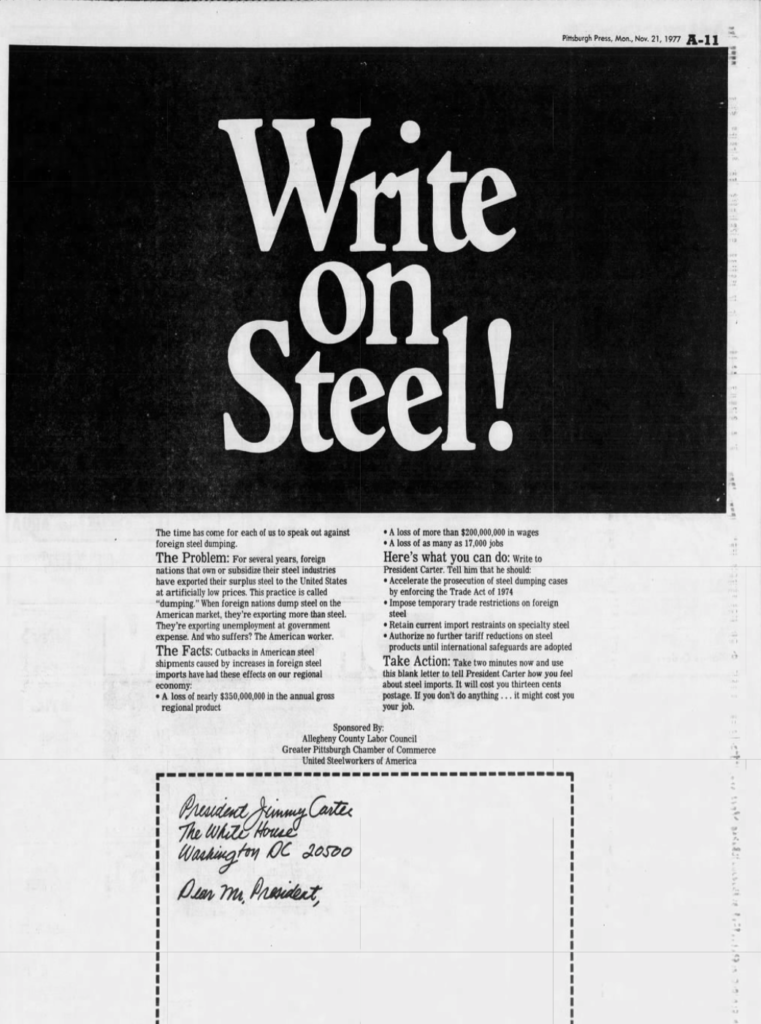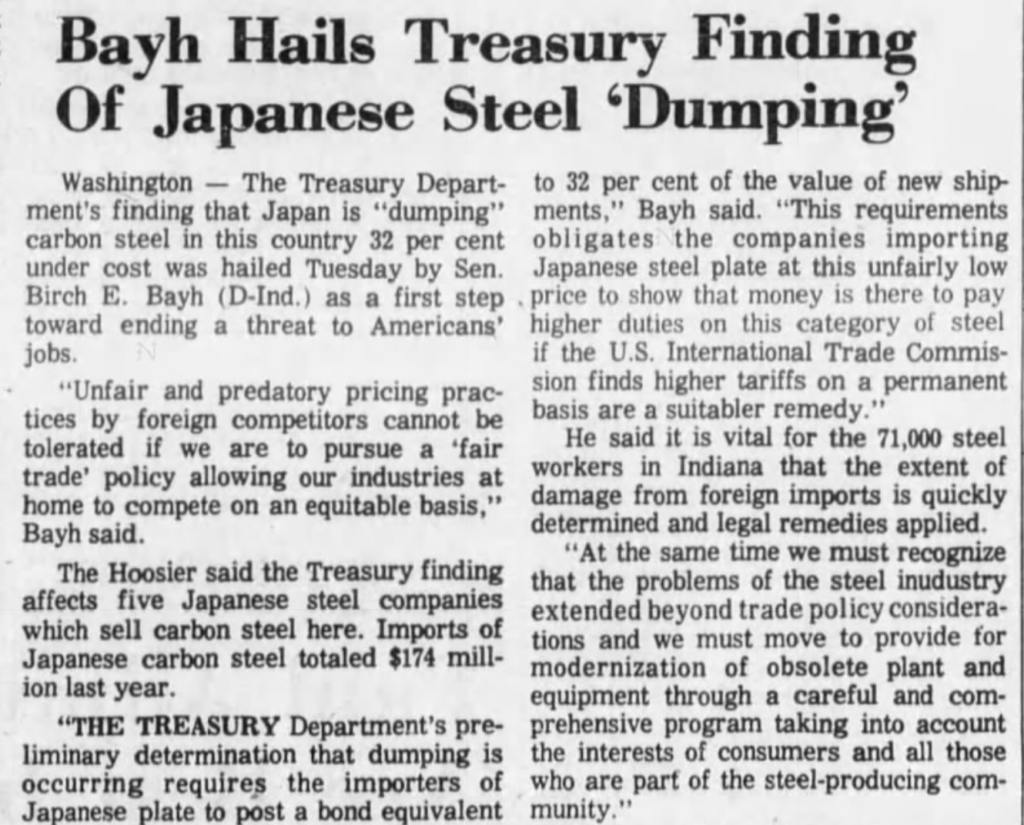
As the U.S. and Japan look to make a deal on steel, we look back at an earlier time when dumped imports threatened American industry.
Foreign steel is being dumped into the United States, causing steelworker layoffs and the closing of American steel mills. In response, steel companies and the United Steelworkers (USW) file a series of complaints with the Treasury Department and the International Trade Commission (ITC) citing unfair competition, injury to America’s steel industry and national security concerns.
If this seems like the actions of communist China and the American response during the past 15 years, you would be correct. But long before China’s market distorting practices wreaked havoc on the American steel industry, there was another foreign player threatening national security by dumping cheap steel into the American market.
In the late 1970s and early 1980s, Japan found a loophole that allowed it to sell its steel products in the U.S. for less money than what the domestic industry could produce.

Decades later, with talk of a looming trade deal between the United States and Japan on “Section 232” steel tariffs, it is worth reflecting on what happened the last time steel came between the two allies.
Dan Boone was a young steelworker at Republic Steel in Cleveland when he first realized there was more to being a steelworker than just putting in a hard day’s work and collecting a good salary to support a family.
“It was like in 1976, I think, and the steel industry was going pretty good yet, and that wave of Japanese steel hit, and they just kept dumping and dumping,” said Boone, who next year will celebrate 50 years of employment at the Cleveland Works mill, now under the ownership of Cleveland-Cliffs. “Then we got into a price war, and it was a race to the bottom. People lost their jobs. I was laid off for a year during that time.”
Boone is currently the contract coordinator of the USW in Cleveland, but he served many of his years as an officer in USW Local 979 including two terms as president.
“We heard about the Japanese dumping steel all the time from the union because the Steelworkers have always been proactive and they understand trade,” Boone said. “There was a time when the American steel industry couldn’t meet the demands for steel in the United States, so at that time there was room for imports. Once the floodgates opened, they just shipped it and dumped it. The Steelworkers have always believed in fair trade, but not free trade.
“After a while, their trade practices were no different than China’s today. They just dumped it in here until they got undercut by China the same way they undercut us. They were selling steel way below what it cost them to make it and they were dumping it here for far less than we could make it.”
At one point early in the Carter administration, the Treasury Department assessed a “dumping” duty of 32% on the Japanese steelmakers who were selling carbon steel plate in the U.S. for $210 per ton. The Treasury Department determined a reasonable price for the Japanese steel should have been $285 per ton.
“If you look at how many steel companies closed over the years, it was because of that,” Boone said. “And how do you blame a consumer or business if they can get the product for $100 a ton cheaper and you’re buying in volume? It’s hard to fault them. It was the fault of the government for permitting it.”
Mike Milsap Sr. is the District 7 Director of the USW, representing the largest steelmaking district in America. He began his steel industry career in 1973 working at Republic Steel in Gary, Ind. Now in his 49th year of representing America’s steelworkers, he still recalls when an abundance of steel from Japan hit American shorelines.
“I do remember the imports from Japan, and they were the big hitter,” Milsap recalled. “It wasn’t China. I do recall massive layoffs in the industry.
“We got impacted. Not only did they have the imports, they were importing cars, which was reducing the number of cars being made in the U.S. There were huge layoffs in the steel industry. We weren’t getting as much steel business because of all the imported Japanese cars. Plants shut down and layoffs were massive.”
Milsap and Ed Cook, his predecessor as president of USW Local 3069, tried to take morale matters into their own hands by giving members of the public in the heavily populated steelworker communities around Gary a chance to get their frustrations out on Japanese cars, manufactured, of course, with Japanese steel.
“I had a junkyard that donated Japanese cars and we took them to different Wiseway Grocery stores here and put them in the parking lot,” Milsap said. “These communities were made up of a lot of steelworkers, so they gave me permission to have a sledgehammer and charge people a dollar a whack at the cars because there was a shortage in the auto industry which was impacting the steel industry huge. They were steelworker fundraisers.”

“I think back then when they were importing so many cars from Japan, they started things like you couldn’t have a foreign car in the parking lot at the mill. Japan was a big player, and the imports were hurting the American manufacturing,” Milsap added. “I remember back when my younger brother had bought a used Honda, or some Japanese car, and I wouldn’t let him park it in my driveway. He had to park it out on the street.”
While the American auto industry did eventually receive some relief from the Reagan administration concerning the influx of Japanese imports, the steel industry was not so fortunate. The American steel companies and the USW have been fighting the overcapacity of foreign steel imports onto our shores for more than 60 years.
“The Japanese were crushing the auto industry and importing steel, too,” Milsap said. “There was a huge fight about buying American-made cars and obviously that helps all the manufacturing.
“It’s amazing that the Steelworkers have been fighting imports and arguing since the 1950s that this is going to be devastating to the U.S. if somebody doesn’t get control of it.
“In the ‘70s, it was Japan, and the last decade and a half, it’s been China. In the late ’70s and early ’80s it was Japan, and then China became the big player.”
Cook, at the age of 70, is retired and wintering in Florida after working 42 years at Republic Steel in Gary. He preceded Milsap as president of USW Local 3069 in the early 1970s. He too recalled the problems the influx of Japanese steel caused the American industry.
“We had the highest productivity in the world, but still couldn’t meet the prices of what they were shipping in from Japan,” said Cook, who worked at the Gary mill from 1973 through 2015. “That’s because the governments were transferring their unemployment to us.
“Back then, Japan had that guaranteed job for life. They had people sweeping the streets so if they were going to pay them anyway, if you can cut 60% of your cost by shipping your steel over here at a 40% loss, you’re still 60% ahead is the way we looked at it back then.
“I’d say it was in 1974 was the first time I heard anything about it. They called us in for a meeting and it was, ’Where’s Joe?’– and Joe was gone because of the Japanese imports. The imports caused us to have to make concessions in our contract.
“With the Japanese steel coming in, you went from working six days a week with lots of overtime to working four days a week with half the crew. They weren’t buying our steel; they were buying Japan steel.
“You understand why they did it. The cost was cheaper, and their quality was better, too. We didn’t care about quality because we were the only game in town forever. We were a small plant.”

Doug May is a retired steelworker who began working in 1973 at Granite City Steel in southern Illinois, directly across the Mississippi river from St. Louis. Owned by U.S. Steel today, Granite City was then a division of National Steel.
May first took notice of the abundance of Japanese cars and steel that were coming into the U.S. when he was a young father of two sons seeking stability at work to provide for his young family.
“Japan dumping steel on our shore coincided with the UAW members and their families leveraging Congress into passing helpful legislation for the Big Three automakers,” May said. “I understood this was a victory, but I would complain ‘what about us?’
“The same scenario was affecting the steel industry, but the dumping of the Japanese steel seemed to be less than a priority for legislators in Washington, D.C. The U.S. steelmakers and, as time wore on, the automakers, were being outperformed by Japan and their superior technology advancements. Our employers didn’t invest in new technology until recognizing the concept of foreign competition was here to stay.”
May went even as far as enrolling in a Japanese language and sociology classes as the Japanese were entering into joint ventures with U.S. steelmakers on American soil. It was a different factory atmosphere and May was just trying to protect his livelihood to support his growing young family.
Several of the major American steel companies at the time such as National Steel, LTV and J&L were sending representatives to Japan to study how the Japanese formed working partnerships in their mills that produced smarter and harder-working employees.
But as Cleveland’s Dan Boone points out, “it was a different time and they forced us to become leaner and meaner. Today we make the best steel anywhere in the world.”
“The fact that Japan is asking for relief now tells me what they want to do,” Boone continued. “I think their intent is pretty clear. Japan and then China. It’s like you fix one leak and then you spring another. If you don’t keep an eye on it, it just comes back to haunt you from somewhere else.
“Any time we’ve been impacted by imports, we’ve never benefitted profitably. They always hurt us.”
Stockton Grunewald contributed to this report.
